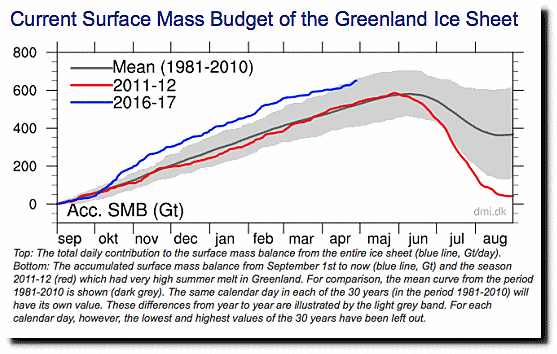At the contentious interface of climate science and policy, there’s one thing that people of all flavors agree upon: if Greenland were to shed all its ice in a century that would be an unmitigated catastrophe, raising sea levels an average of 22 feet simply from the sheer volume of water contained thereon.
It therefore stands to reason that a melting Greenland makes for good copy, and The Economist’s witty scribes have just published two alarming articles (here and here). Alarming, that is, because they left out a few pertinent facts.
“The most worrying changes are happening in Greenland, which lost an average of 375bn tonnes of ice per year between 2011 and 2014.”
This is a finely selected cherry that The Economist plucked. 2012 was an exceedingly warm year averaged over the island-continent. Had they included all the recent data, they would have shown that the surface mass balance budget of ice on Greenland recently reached a record high compared to the previous three decade. This is simply the accumulation of ice and snow minus losses from melting and and sublimation (the direct evaporation of snow), and you can see how unusual 2012 was in the figure below. The net ice loss is the accumulation minus the calving of glaciers, which, according to the Danish Meteorological institute (DMI) is about 200 gigatonnes (billion metric tons) per year.
Source: Danish Meteorological Institute
“This is equivalent of over 400 massive icebergs measuring 1km on each side disappearing each year.”
At the turn of this century, the U.S. Geological Survey reported the volume of Greenland’s ice at 2,600,000km3. The maximum melt of 400km3 is a grand total of 1/5000th of its ice.
The United Nations’ Intergovernmental Panel on Climate Change (IPCC) projects that melting of Greenland’s ice will raise sea level a bit under one-tenth of a meter, or three inches by 2100.
“Even if current emissions remain stable, the consensus is that global sea levels will rise 74cm [29 in] by the end of the century.”
Nope. The same IPCC science summary projects around 38cm [15in] for this scenario.
With regard to the much-feared sudden loss of Greenland’s ice, we read that “little is known about how Greenland’s vast ice sheet will react to future warming.”
Well, when it comes to the big one, no, not really. A 2013 ice core got all the way back to the beginning of the previous interglacial, when there was a 6,000 year period of very warm summer temperatures. Prior to this work by Dorthe Dahl-Jensen and her colleagues, it was thought summer temperatures in this period, called the Eemian, were about 2⁰C warmer than the 20th century average over northwest Greenland, where the core was drilled.
Instead, Dahl-Jensen found that it averaged a whopping 6⁰ warmer. She estimated this was associated with a maximum loss of about 30% of Greenland’s ice. That may be charitable because where she drilled, in the cold northwestern region, the ice core revealed that the thickness of the ice was reduced by about 10%. Another, more recent study also found 6⁰C of warming, this time at Summit, where Greenland’s ice cap reaches maximum elevation. That work did not use the ice itself to estimate the Eemian altitude, but a computer model, which showed around a 70% loss of total Greenland ice.
So this much heat rained down on Greenland during the Eemian: 6⁰C X 6,000 summers, or 36,000 degree-summers. And let’s say, maybe, humans could warm it 5⁰C for 500 summers, or 2,500 degree-summers. That would only knock 2500/36000 of the maximum 30% of the ice off, or two percent. This works out to five inches of sea-level rise from the melting of Greenland in the first study and 13 in the second one.
Most Economist readers aren’t aware of the true nature of the literature on Greenland’s ice and don’t have a friendly climatologist to supply them the important links The Economist didn’t. No wonder so many are worried.

